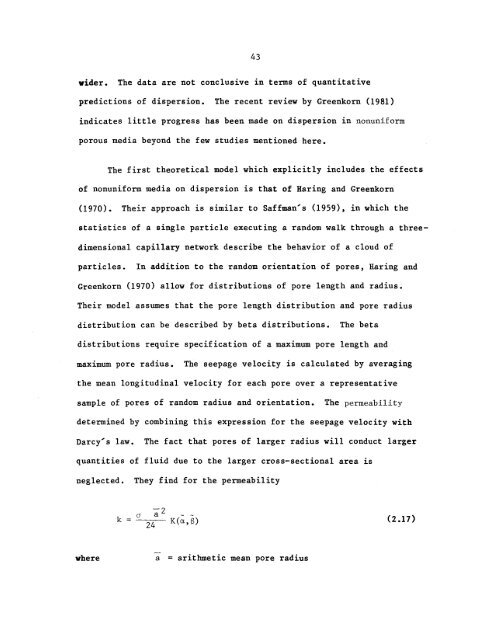longitudinal dispersion in nonuniform isotropic porous media
longitudinal dispersion in nonuniform isotropic porous media
longitudinal dispersion in nonuniform isotropic porous media
Create successful ePaper yourself
Turn your PDF publications into a flip-book with our unique Google optimized e-Paper software.
wider. The data are not conclusive <strong>in</strong> terms of quantitative<br />
predictions of <strong>dispersion</strong>. The recent review by Greenkorn (1981)<br />
<strong>in</strong>dicates little progress has been made on <strong>dispersion</strong> <strong>in</strong> <strong>nonuniform</strong><br />
<strong>porous</strong> <strong>media</strong> beyond the few studies mentioned here.<br />
43<br />
The first theoretical model which explicitly <strong>in</strong>cludes the effects<br />
of <strong>nonuniform</strong> <strong>media</strong> on <strong>dispersion</strong> is that of Har<strong>in</strong>g and Greenkorn<br />
(1970). Their approach is similar to Saffman's (1959), <strong>in</strong> which the<br />
statistics of a s<strong>in</strong>gle particle execut<strong>in</strong>g a random walk through a three-<br />
dimensional capillary network describe the behavior of a cloud of<br />
particles. In addition to the random orientation of pores, Har<strong>in</strong>g and<br />
Greenkorn (1970) allow for distributions of pore length and radius.<br />
Their model assumes that the pore length distribution and pore radius<br />
distribution can be described by beta distributions. The beta<br />
distributions require specification of a maximum pore length and<br />
maximum pore radius. The seepage velocity is calculated by averag<strong>in</strong>g<br />
the mean <strong>longitud<strong>in</strong>al</strong> velocity for each pore over a representative<br />
sample of pores of random radius and orientation. The permeability<br />
determ<strong>in</strong>ed by comb<strong>in</strong><strong>in</strong>g this expression for the seepage velocity with<br />
Darcy's law. The fact that pores of larger radius will conduct larger<br />
quantities of fluid due to the larger cross-sectional area is<br />
neglected. They f<strong>in</strong>d for the permeability<br />
k K(a,S) (2.17)<br />
where a = arithmetic mean pore radius

















